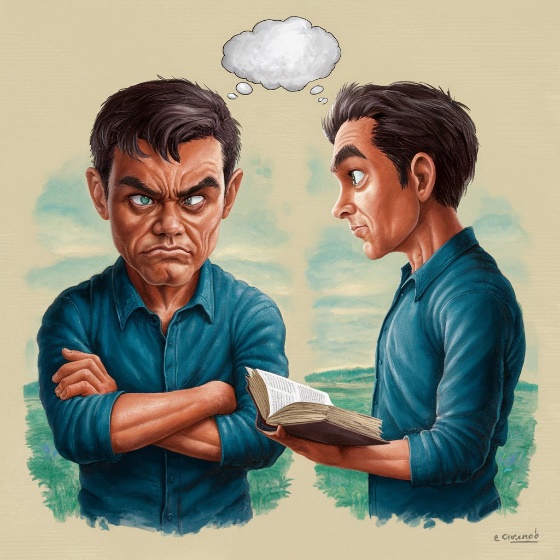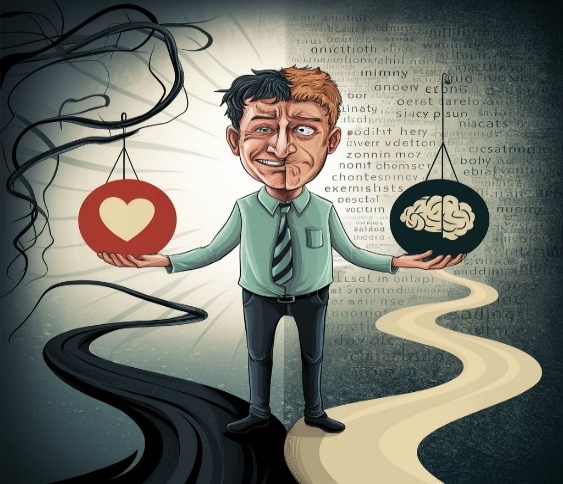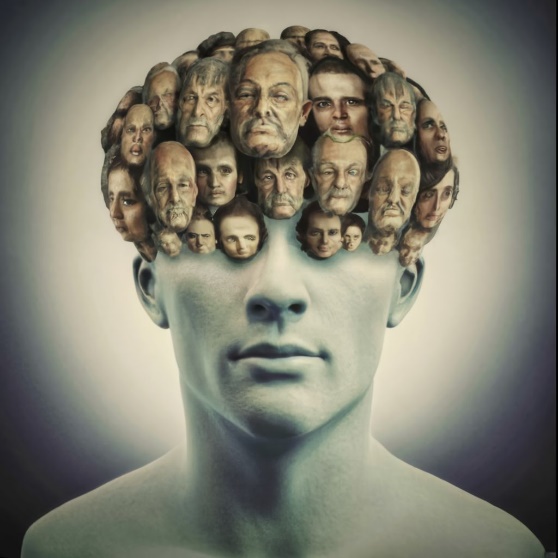Conversation 50: Changing attitudes in the set of internalized figures
Greetings,
Attitudes affect the way we perceive and respond to the world around us. Attitudes can influence our decisions, actions, preferences, and evaluations.
Attitudes are created through a complex interplay of various factors, including:
Socialization: Attitudes are often shaped during the socialization process, which occurs mainly in childhood and adolescence. Family members, peers, teachers, and significant others influence the development of attitudes through direct instruction, observation, and reinforcement.
Cognitive processes: Attitudes can be formed through cognitive processes such as reasoning, evaluation and judgment. People may develop attitudes based on beliefs, values, and interpretations of information.
Personal experiences: Personal experiences play a significant role in shaping attitudes. Positive or negative experiences with certain objects, people or situations can influence the formation of attitudes towards them.
Media and Communication: Mass media, including television, movies, the Internet, and social media platforms, can shape attitudes by exposing people to certain ideas, values, and perspectives.
Cultural and social influences: cultural norms, traditions and social expectations contribute to the formation of attitudes. People often adopt attitudes that are consistent with the values and beliefs of their culture or social group.
Emotional reactions: emotional reactions to stimuli can also affect the formation of attitudes. People may develop positive or negative attitudes based on their emotional responses to specific objects, people, or situations.
Personal characteristics: individual differences, such as personality traits, self-esteem, and cognitive abilities, can influence the formation of attitudes. For example, people with high levels of openness to experience may be more open to forming new attitudes, while those with low self-esteem may be more resistant to attitude change.
In general, attitudes are dynamic and can evolve over time in response to new information, experiences, and social influences. In addition, attitudes can vary in strength and stability, from fleeting opinions to deeply held beliefs.
Some hold that attitudes have three components: emotional, cognitive and behavioral. The emotional component refers to the emotional feelings we have towards a position object. The cognitive component refers to the beliefs and thoughts we have about a position’s object, such as facts or opinions. The behavioral component refers to the actions we take or intend to take towards a position’s object.
Attitudes can be explicit or implicit. Explicit attitudes are those we express and report consciously. Implicit attitudes are those we unconsciously hold and reveal, such as showing a preference for a person object or attitude over others. Expressed and implied attitudes can sometimes be consistent or inconsistent with each other.
Forming attitudes is a process of developing a relationship towards a new object, person, thing or event. There are many factors that can influence the formation of attitudes, such as experience [direct personal experience or observation], the set of associations related to an object or event, a belief system, social factors [such as social norms, family and peers, affiliation groups, etc.] and economic [influence on access to resources] and more .
Attitude-behavior relationships are the relationship between our attitudes and our actions. Attitudes can influence behavior by guiding our choices, intentions, and motivations. Behavior can also influence attitudes by providing feedback, consequences, or reinforcement. Below are several theories that explain how attitudes are formed, change, and influence behavior:
Cognitive Dissonance Theory: This theory was proposed by Leon Festinger in his book "Cognitive Dissonance Theory" published in 1957.

Leon Festinger [1919 – 1989]
Festinger was a social psychologist known for his work on cognitive dissonance and social comparison theory. The theory suggests that people strive for consistency between their attitudes and their behavior. When there is inconsistency, for example when a person's behavior contradicts his attitude, he experiences cognitive dissonance – an uncomfortable feeling. To reduce this dissonance, people may change their attitudes to align with their behavior.


AI-assisted illustrations to illustrate cognitive dissonance
Social Learning Theory: developed by Albert Bandura, who introduced the idea in the sixties. Bandura is a prominent psychologist known for his contributions to social cognitive theory and his pioneering work on observational learning and modeling. This theory emphasizes the role of observational learning and modeling in forming attitudes.
According to this theory, people acquire attitudes by observing the behavior of others, especially those they admire or identify with. Through this observational learning process, people adopt attitudes that match the attitudes and behaviors of the people they observe.
Self-Perception Theory: was proposed by Daryl Bem in his article "Self-Perception: An Alternative Interpretation of Cognitive Dissonance Phenomena" published in 1967. Bem was a social psychologist whose research also contributed to gender studies and personality psychology.
The theory suggests that people infer their attitudes from their own behavior when their attitudes are uncertain or ambiguous. According to this theory, people observe their own behavior and use it as a cue to infer their attitudes. For example, if someone volunteers to participate in environmental clean-up activities, they may conclude that they have a positive attitude towards environmental conservation.
Attribution Theory: first formulated by Fritz Haider in his book "The Psychology of Interpersonal Relations" published in 1958. Harold Kelly continued to develop attribution theory in the sixties, especially in relation to social perception and interpersonal behavior. The theory focuses on how people explain the causes of the behavior, including their own and others.
According to attribution theory, people form attitudes based on their attributions for the causes of behavior. For example, if someone attributes their friend's generosity to their kind and caring nature, they may develop a positive attitude toward their friend.
The Elaboration Likelihood Model (ELM): Developed by Richard Petty and John Cacioppo, presented in their book "Communication and Persuasion: Central and Peripheral Pathways to Attitude Change" published in 1986. Petty and Cacioppo are both psychologists known for their research on attitudes, persuasion and social cognition.
ELM offers two paths to attitude change: the central path and the peripheral path. According to this model, the central pathway involves considering the arguments presented, while the peripheral pathway involves more superficial cues, such as attractiveness or credibility of the source. Attitudes formed through the central route tend to be more durable and resistant to change compared to attitudes formed through the peripheral route.
In addition to the models above, other models were also offered such as:
Dual Process Models. Mechanism: Dual process models suggest that attitude change can occur through both systematic processing (careful evaluation of arguments) and heuristic processing (reliance on mental shortcuts or heuristics). Access may vary depending on the processing route used.
Functional Theory of Attitudes. Mechanism: This theory proposes that attitudes serve specific functions, such as providing social approval to individuals, maintaining social order, or satisfying personal needs. Positions vary according to the functions they serve in different contexts.
Balance Theory. Mechanism: Balance theory suggests that people strive for consistency in their attitudes and relationships. Attitude change occurs when there is an imbalance between attitudes and the perceived relationships between objects, individuals and events.
Emotional Integration Theory. Mechanism: Attitude change occurs through the integration of emotional responses, or feelings, with cognitive appraisals. This theory suggests that attitudes are formed based on the emotional responses evoked by stimuli.
Behavioral theory of attitude change. Mechanism: According to this theory, attitudes change as a result of direct experience and reinforcement. Attitudes are shaped through interactions with the environment and the consequences of behavior.
These theories offer different perspectives on how attitudes are formed and influence behavior and provide insights into the psychological processes underlying the formation and change of attitudes.
Changing attitudes can also be analyzed according to the source, the message and the receiver:
Source factors: These are the characteristics of the sender of the message, such as credibility, attractiveness and similarity to the recipient of the message. Source factors can influence attitude change by influencing the message recipient's attention, interest, and trust. For example, if the sender of the message is an expert, celebrity, or friend, the recipient of the message is more likely to notice, be interested in, and trust the message, and therefore more likely to change their attitude.
The recipient's factors: these are the characteristics of the recipient of the message, such as motivation, ability and state of arousal and mood. Recipient factors can affect attitude change by influencing the recipient's engagement, processing, and response to the message.
For example, if the receiver of the message is motivated, capable and in a positive mood, he is more likely to be involved, work deeply and respond positively to the message, and therefore more likely to change his attitude.
Message characteristics factors: These are the characteristics of the message delivery, such as timing, location and medium. Contextual factors can affect attitude change by influencing the exposure, attention, and distraction of the message recipient.
For example, if the delivery of the message is timely, appropriate and effective, it is more likely that the receiver of the message will be exposed to the message, pay attention to it and not be distracted, and therefore more likely to change his attitude.
An example of the importance of the characteristics of the message is the difference in the reception of the message between that of Semmelweis and that of Florence Nightingale:
Thus Ignaz Philip Semmelweis (1865-1818) was an Austro-Hungarian physician, gynecologist and pioneer of the field of epidemiology.

Stamp in memory of Ignaz Semmelweis, 1955
Semmelweis discovered in 1847 that washing hands with disinfectant in maternity hospitals greatly reduces the risk of infection.
Semmelweis's hypothesis was not widely accepted, as it was not supported by the accepted scientific theories at that time. One reason was that the evidence supporting it was presented in a tedious statistical manner without charts or graphs.
Florence Nightingale (1820 – 1910), on the other hand, was an English nurse, writer and statistician whose groundbreaking work in nursing stood out during the Crimean War, when she treated wounded soldiers.
Florence Nightingale
Her service as a nurse in the Crimean War resulted in Nightingale's primary publicity. Nightingale believed that their high mortality rates were caused, among other things, by poor sanitary conditions, after her return to England she was able, with the help of the evidence she brought, to convince the responsible parties of this, among other things following Nightingale's main contribution to the profession of statistics through the development of graphic means of presenting statistical data, which were understandable both for experts in the field and for people without prior knowledge of statistics, including many of the decision makers.
Message content factors: These are the characteristics of the message content, such as quality, length and emotional expression. Message factors can influence attitude change by influencing the message recipient's understanding, memory, and evaluation.
For example, if the content of the message is clear, concise and persuasive, the recipient of the message is more likely to understand, remember and agree with the message, and therefore more likely to change their attitude.
As a rule, attitude change can occur through different processes and mechanisms. Some common ways positions can change include:
Persuasion: Persuasion involves a deliberate attempt to change someone's attitudes or beliefs through communication. Persuasion can occur through various means, such as presenting arguments, appealing to emotions, using reliable sources, and using persuasive techniques such as foot-in-the-door or door-in-the-face strategies.
Social influence: Attitudes can be influenced by the attitudes and behaviors of others in social settings. Social influence can occur through processes such as conformity, where people change their attitudes or behaviors to conform to a group, or through social comparison, where people evaluate their own attitudes and beliefs by comparing them to those of others.
Cognitive dissonance: Cognitive dissonance occurs when people experience discomfort or tension due to inconsistencies between their attitudes, beliefs, and behaviors. To reduce this discomfort, people may change their attitudes to align with their behavior or justify their behavior to maintain consistency.
Direct experience: Attitudes can change as a result of direct personal experiences. Positive or negative experiences with certain objects, people or situations can lead to changes in attitudes towards them.

AI-assisted illustration: entering a world of direct emotional experience
Information Processing: Attitudes can change through the processing of new information or evidence. When people encounter new information that challenges their existing attitudes or beliefs, they may reevaluate their attitudes and update their positions accordingly.
Socialization: Attitudes can be shaped through a process of socialization, which occurs through interactions with family, peers, teachers, and other social influences. Over time, exposure to different social agents and different experiences can lead to changing attitudes and values.
Cultural and social changes: Attitudes can change as a result of wider cultural or social changes. Changes in social norms, values and expectations can affect people's attitudes towards various issues, such as gender roles, diversity and environmental sustainability.
A change of position is a dynamic process influenced by a variety of factors, and it can occur gradually or suddenly depending on the circumstances and the individual's openness to change.
We will also note that there are a number of real-life circumstances or life events that can lead to basic and fundamental attitude changes in people. Some of these circumstances include:
Traumatic events: Experiencing a traumatic event, such as natural disasters, accidents or personal crises, can challenge an individual's existing beliefs and perspectives. These events may cause people to re-evaluate their values, priorities and attitudes towards life and the world around them.
Major life transitions: Major life transitions, such as moving to a new country, starting a new job, getting married, or becoming a parent, can trigger attitude changes. These transitions often require people to adapt to new environments, roles and responsibilities, which can lead to changes in their attitudes and beliefs.
Critical Incidents: Specific incidents or encounters with others, such as conflicts, confrontations, or moments of deep insight, can challenge people's existing attitudes and beliefs. These critical incidents may cause people to reevaluate their perspectives and consider alternative perspectives.
Education and learning: Exposure to new information, ideas and perspectives through education, travel or intellectual inquiry can broaden people's horizons and lead to a change in attitude. Learning about different cultures, philosophies and disciplines can challenge existing assumptions and foster open-mindedness.
Social Movements and Advocacy: Participating in social movements, activism, or advocacy efforts can inspire people to reexamine their attitudes and values, especially regarding social justice, equality, and human rights issues. Involvement in such movements can lead to a profound change of attitude and a commitment to social change.
Personal growth and self-reflection: Engaging in introspection, self-reflection, and personal development activities can facilitate attitude changes. Through self-awareness and self-inquiry, people may identify areas for growth, confront biases or prejudices, and cultivate more positive attitudes toward themselves and others.
Exposure to diverse perspectives: Interacting with people from diverse backgrounds, cultures, and perspectives can challenge people's preconceptions and encourage changes in attitudes. Exposure to different perspectives through dialogue, collaboration and empathy-building exercises can promote tolerance, understanding and acceptance.
Health and Wellness: Health-related experiences, such as illness, injury, or lifestyle changes, can cause people to reevaluate their attitudes toward health, well-being, and self-care. Facing health challenges or watching the struggles of others can lead to a change in attitudes about personal responsibility, resilience and self-care practices.
Technological progress: The progress of technology and access to information can expose people to new ideas, innovations and ethical dilemmas, and cause changes in attitude. Issues related to privacy, artificial intelligence and environmental sustainability, among others, may lead people to reevaluate their attitudes and behaviors in response to technological developments.
Moral dilemmas and ethical decision-making: dealing with moral dilemmas or ethical decision-making situations can challenge an individual's moral values and ethical principles, and lead to a change in attitude. These experiences may cause people to reconsider their beliefs, values and moral responsibilities in complex and ambiguous situations.
We note that changing an approach, especially if it is a basic approach, is not a simple process that is often resistant to elements of change. Most people insist on holding the same attitudes throughout their lives and change them usually involuntarily. In fact, it seems that these basic attitudes and positions play a central role in defining ourselves, or in other words in defining our self-identity.
Changing attitudes can be challenging for several reasons. Here are some key factors that contribute to the difficulty:
Negative emotions: People are often motivated by negative emotions such as regret, shame, fear and guilt. While these feelings can initiate the desire to change, they are not effective in sustaining change long-term.
Thinking errors: "All or nothing" thinking can lead people to believe that they must change completely and immediately, which is unrealistic and sets them up for failure.
These reality circumstances can have profound effects on people's attitudes, beliefs and values, and lead to fundamental changes in their worldview and behavior.
Formulating big and decisive goals for change: trying to change too much at once can be beyond a person's strength. It is more effective to start with small and specific actions and build on them over time.
Prior commitments: Prior commitments can act as barriers to changing attitudes, especially if they are strong or publicly expressed.
Credibility and information: Low credibility of the source supporting the change or insufficient information can delay attitude change.
Fear: The degree of fear associated with change can also be a barrier, as it can prevent people from taking the necessary steps.
These factors emphasize the complexity of human behavior and the need for a positive and well-structured approach to facilitate change. It is important to understand that change is a process that occurs in stages and requires patience and perseverance.
In general, theories of attitude change, including those discussed in the field of social psychology, suggest that attitudes are difficult to change due to their complex nature. They are often deeply rooted in personal experiences, social influences and cognitive biases.
Theories such as cognitive dissonance [see above] suggest that people experience discomfort when their beliefs are challenged, leading them to resist change in order to maintain consistency.
Social cognitive theory also emphasizes the role of environmental factors and self-efficacy in behavior and attitude change. Attitudes are not just private thoughts but are related to identity, social norms and past behaviors, which often makes them resistant to change.
These general principles from social psychology may provide insight into why attitude change is a complex process that involves more than simply presenting new information or arguments. It often requires addressing underlying emotional, cognitive and social factors [see above].
In this regard, changing religious attitudes can be particularly difficult due to a combination of deep beliefs, cultural traditions and personal identity. Here are some factors that contribute to the challenge:
Rooted beliefs: religious beliefs are sometimes assimilated from a young age and are deeply embedded in a person's identity and worldview.
Cultural and social integration: Religion is not only a belief system but also a cultural and social system. Changing religious attitudes can also mean changing one's position in social and family structures.
Emotional and psychological investment: People invest emotionally and psychologically in their religious beliefs, which can provide comfort, community, and a sense of purpose.
Fear of uncertainty: moving away from familiar religious beliefs can lead to uncertainty and fear of the unknown, which is a strong deterrent to change.
Cognitive Dissonance: When new information challenges existing beliefs, it can create cognitive dissonance. People tend to resolve this discomfort by rejecting the new information rather than changing their beliefs.
Intergenerational transmission: Religious attitudes are often passed down from generation to generation, creating a strong sense of tradition and resistance to change.
These factors make religious attitudes more resistant to change than other types of attitudes. It requires not only a change in thinking, but often a change in many aspects of one's life and relationships.
As mentioned, we assume that the individual's social self consists of the internalization of influential figures in his life, arranged in a hierarchical order with one or more internalized figures having the greatest influence on the individual's attitudes, feelings and behavior, which we have called the the dictator-self (selves) [see previous conversations].

Illustration with the help of AI of the array of internalized characters in the individual
In this framework, where the individual's social self consists of internalizations of influential figures arranged in a hierarchical order, the change of attitude can be understood as a process affected by the dynamics of this internalized hierarchy. This is how the change in attitude can be described against this background:
Hierarchy of internalized characters: Individuals have a hierarchical arrangement of internalized characters, where one or more characters are the most influential in shaping their attitudes, feelings and behavior. This may include parents, teachers, peers, or other significant people who have profoundly influenced the individual's socialization process.
The influence of the internalized figures: attitudes, feelings and behaviors of individuals are influenced by the internalized figures at the top of their hierarchy. These figures shape his perceptions, values and beliefs which he recognizes as his own attitudes and perceptions arising from him as he is usually not aware of the activity of the internalized figures.
Attitudinal consistency and inconsistency: Attitudes that are consistent with the values and beliefs of the most influential internalized characters may therefore be maintained and strengthened. However, when there is an inconsistency between the individual's behavior [whether due to some external influence or an internal figure not usually high in the hierarchy] and the values or expectations of these figures, cognitive dissonance may arise. Such dissonance can also occur within the array of internalized characters when a situation arises in which there is an internalized character that rises in the hierarchy of characters and has a position that opposes the most influential character that we called the inner dictator or dictator-self. This is therefore an internal dissonance within one’s psyche that creates an internal conflict.
Resolving the cognitive dissonance: Attitude change occurs when people strive to reduce the cognitive dissonance between a behavior or position that the individual takes and the expectations of the influencing internal figures or to reduce the internal intrapsychic dissonance. This may involve changing attitudes or behavior in order to align more closely with the values and beliefs of the internalized characters and especially those of the most influential dictator-self and thus restore consistency within the social self. In some cases, following significant key events, it is possible that the alignment of the line will be with an internalized character other than the dictator-self, since the positions of the dictator-self will no longer be compatible with coping in light of the significant event.
Social identity and group dynamics: We note that a change of position may also be influenced by the individual's social identity and group dynamics.
Internalized characters may belong to different social groups, and the individual may experience pressure to conform to the attitudes and norms of these groups, which further shapes their attitudes and behavior.
Developmental considerations: the hierarchical arrangement of internalized characters and their effect on changing attitudes may vary between different developmental stages. For example, parental figures may be more influential during childhood, while peer groups may be more influential during adolescence and adulthood.
Resistance to change: Attitudes that are deeply rooted and consistent with the values of highly influential internalized characters may be more resistant to change. However, as mentioned above under certain circumstances, such as exposure to new information or experiences, people may undergo gradual or sudden changes in their attitudes to accommodate changes within their social self.
In general, the change of attitude in this framework is shaped by the interrelationships between the internalized characters, the social identity, the external environment and its events, cognitive processes and the individual's continuous efforts to maintain consistency and harmony within his social self.
The concept of "dictator-self", as discussed in the context of the RGFT treatment method [see previous talks] refers to internalized figures of the social self that exert a strong influence on the attitudes and behaviors of the individual. These "dictator-selves" can influence attitude change in the following ways:


Illustration with the help of AI – the array of internal characters. The large figure in the center represents the dictator-self
Strong internal influence: The "dictator-self" represents internalized authority figures or aspects of the social self that dictate certain behaviors and attitudes, making it difficult to change these entrenched patterns.
Resistance to change: Because these internalized figures are seen as authoritative, there may be strong resistance to changing attitudes that contradict their influence.
Emotional connections: The "dictator-self" may be associated with extreme negative emotions, rejection or frustration, which may lead to a defensive stance against change.
Effect on self-esteem: the influence of the "dictator-self" can in certain cases lead to extremely low self-esteem, self-hatred and even suicide, which complicates the process of changing attitudes because the individual may lack the self-worth necessary to consider alternative points of view.
Defensive figures: The "dictator-self" may be an internalized figure that conveys a need for love and acceptance from the environment, which can be comforting and therefore more difficult to challenge or change.
In conclusion, the concept of the "dictator-self" suggests that such internalized characters can play a role, and sometimes pathological one, in shaping and maintaining attitudes, making it difficult for people to adopt new points of view or change existing points of view. This concept emphasizes the importance of considering the effects of the internalized characters and especially of the dictator-self when trying to understand changes in attitudes.
In general, we identified 12 different subtypes of "dictator-self" [see previous conversations]. Here we will mention only a few of them that seem more relevant to changes in attitudes.
"State Dictator": This influential and dominant internalized figure is based on the perception of a continuous state of emergency (threat). This subtype of the dictator-self initiates an emergency (virtual or real) which can be related to an external threat (an enemy) or an internal threat (internal chaos and anxiety).
This influential figure filters the content that fits its positions and censors content that contradicts its positions: human objects are seen by it as threatening or weak and it hunts for threatening or weak human objects. If there are none – then she tries to distort the objects in such a way that they are perceived as threatening or weak.
Its inner world is perceived as being very clear, defined and strong. Any opposition to this is seen as coming from outside and arising from the bad intentions of the external "bad" human objects.
If this subtype of the dictator-self prevails, we can expect position changes to occur when the enemy's power seems overwhelming ("If you can't fight them – join them").
Another influential dictatorial figure is of the "moral apostle" type: this is based on the unquestioned moral superiority of the dictator-self. This world view is divided into good and bad. All interactions are judged according to their moral legitimacy based on certain ideals, which are personal in essence, but are seen as universal and not within a personal relationship. Human objects that are seen as illegitimate specifically in the moral sense are rejected in their entirety. The self-perception is of a morally superior self, flawless and with absolute inner integrity.
As a rule attitudes related to moral norms are very difficult to change, if at all. Often this influential figure is associated with religious or ideological beliefs, and often with political extremism.
Another internalized dictatorial figure is that of the "rational dictator" ("positivist scientist"): based on a monopolistic supremacy of acquired positivist knowledge and experience. The main function – information processing. There is considerable devaluation of the emotional approach, based on intuition.
Objects are seen as always being in some logical relationship with each other, each change being caused by something that can be traced, at least theoretically, and can potentially be explained by a logical cause. Self-concept is as a kind of analytical tool. There is a misjudgment of the limitations of logical thinking.
The change of attitudes in this subtype of the dictatorial self can occur when some logical reasoning based on the analysis of the event, object or person, proves that the previous attitude is wrong.
As for the "emotional internalized dictator": objects are perceived as positive, or negative, or in between – according to their emotional values. The interrelationships between them are hierarchical and are measured by the degree of positivity of the emotional valence.
Changes in attitudes can easily occur depending on the emotional perception of the event, person, or group of people. Can be manipulated relatively easily. Widely used by "opinion makers", ideological and political leaders.
Finally, we will mention the dictator of the "social psychopath" type: this is based on the concept that "the ends justify the means". Unlike an ordinary person, here the social rules are accepted only formally (but not internalized) and are used to manipulate objects to achieve personal goals (often violating ethical and moral norms along the way).
Human objects are therefore seen as means to achieve personal goals. They are related to each other in a hierarchical order according to their potential importance in the process of achieving these goals and their potential threat.
Allegedly, there are attitudes in accordance with the demands of his social environment only on the surface, but they will never be implemented in practice.
The treatment techniques in RGFT in cases where the attitudes are contra productive and self-harming are mainly:
1. Exposure of the relevant dictator-self (hot chair technique) in order to uncover the actual sources of the contra productive attitudes
2. Analyzing these attitudes using Socratic questioning in an attempt to devaluate the corresponding dictator-self and lower its placement within the hierarchy of the internalized “directorate of characters”
3. Promoting the internalized characters that carry the more productive attitudes in an attempt to raise their position in the internal hierarchy of characters
4. Creating the internalized character of the therapist (specifically designed for that purpose) with open and flexible attitudes supporting better adaptation abilities
That's it for now
yours,
Dr. Igor Salganik and Prof. Joseph Levine
 Prof. Joseph Levine, M.D. is an emeritus associate professor in the Division of Psychiatry, Faculty of Health Sciences, Ben Gurion University in Israel. Prof. Levine is a certified psychiatrist with clinical experience in controlled trials of adult psychiatric disorders and in psychotherapy. He was awarded a NRSAD independent investigator grant for the study of Creatine Monohydrate in psychiatric disorders -- mainly Schizophrenia. He resides and treats patients in Tel Aviv and all of central Israel.
Prof. Joseph Levine, M.D. is an emeritus associate professor in the Division of Psychiatry, Faculty of Health Sciences, Ben Gurion University in Israel. Prof. Levine is a certified psychiatrist with clinical experience in controlled trials of adult psychiatric disorders and in psychotherapy. He was awarded a NRSAD independent investigator grant for the study of Creatine Monohydrate in psychiatric disorders -- mainly Schizophrenia. He resides and treats patients in Tel Aviv and all of central Israel.

Leave a comment